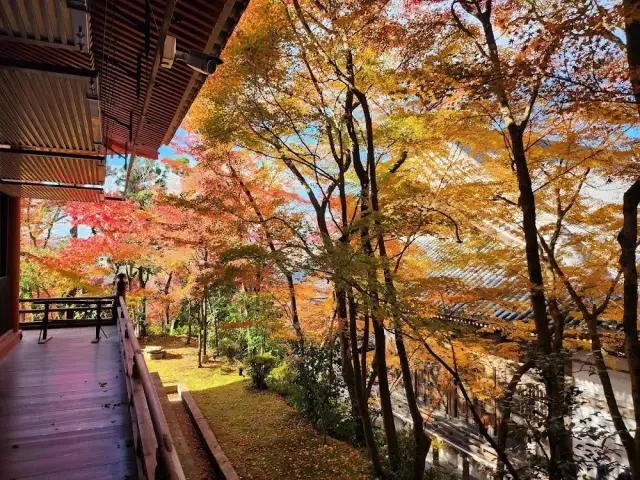https://www.dekitabi.com/itinerary/philosopher’s-path-temples-tour
Kyoto, a city renowned for its rich cultural heritage and breathtaking temples, offers visitors a tapestry of experiences steeped in tradition and beauty. Among its many treasures, Okazaki Shrine, Konkai Komyoji, Shingokurakuji Temple, Higashiyama Jisho-ji, Eikando Zenrinji, and Nanzen-ji Temple stand out as exceptional destinations for anyone looking to explore the spiritual and historical depths of Japan. Each of these sites provides a unique glimpse into Kyoto’s past, with lush gardens, architectural marvels, and serene surroundings.
Okazaki Shrine: A Peaceful Retreat

https://www.dekitabi.com/attraction/okazaki-shrine
Nestled in the heart of Kyoto’s Okazaki district, Okazaki Shrine is a tranquil haven dedicated to the deity of the Heian period. Established in 794 AD, the shrine’s location offers visitors a serene escape from the city’s hustle and bustle. The approach to Okazaki Shrine is lined with picturesque cherry trees that bloom in spring, creating a canopy of delicate pink flowers. The shrine’s main hall, adorned with traditional Japanese architecture, serves as a focal point for worshippers and tourists alike. The shrine is particularly famous for its annual festivals, which celebrate the vibrant cultural heritage of Kyoto.
Key Attractions:
- Cherry Blossom Viewing: The shrine’s grounds are an ideal spot for cherry blossom viewing during the spring season.
- Annual Festivals: Experience traditional Japanese festivals that showcase local customs and rituals.
Konkai Komyoji: A Hidden Gem of Kyoto

https://www.dekitabi.com/attraction/konkai-komyoji-temple
Konkai Komyoji Temple, located in the southern part of Kyoto, is a lesser-known but equally fascinating site. Founded in 1594 by the renowned Tokugawa shogunate, this temple offers a glimpse into the religious and architectural styles of the late Edo period. The temple is known for its stunning gardens and traditional tea houses, providing a peaceful retreat from the urban environment. The intricate details of the temple’s architecture, coupled with its well-maintained gardens, make Konkai Komyoji a must-visit for those interested in Japanese culture and history.
Key Attractions:
- Edo Period Architecture: Marvel at the architectural style from Japan’s Edo period.
- Traditional Gardens: Explore beautifully maintained gardens that offer a peaceful atmosphere.
Shingokurakuji Temple: A Sanctuary of Zen

https://www.dekitabi.com/attraction/shinnyodo-temple-kyoto
Shingokurakuji Temple, often referred to as “Shin-kurakuji,” is a significant Zen temple located in the northern part of Kyoto. Established in the 12th century, this temple is a renowned site for those interested in Zen Buddhism. The temple’s serene environment, with its meticulously landscaped gardens and traditional tea houses, provides a perfect setting for meditation and reflection. Shingokurakuji’s historical significance is further highlighted by its association with the Rinzai sect of Zen Buddhism, which played a crucial role in shaping Japan’s spiritual landscape.
Key Attractions:
- Zen Meditation: Engage in Zen meditation practices and experience the tranquility of the temple’s environment.
- Historical Significance: Learn about the temple’s role in the development of Zen Buddhism in Japan.
Higashiyama Jisho-ji: The Silver Pavilion

https://www.dekitabi.com/attraction/ginkakuji-temple-(higashiyama-jisho-ji)
Higashiyama Jisho-ji, commonly known as the Silver Pavilion, is a UNESCO World Heritage Site renowned for its stunning architectural and natural beauty. Originally built as a retirement villa for the shogun Ashikaga Yoshimasa, the temple is celebrated for its elegant simplicity and harmonious integration with its natural surroundings. The Silver Pavilion’s gardens, including the famous sand garden and moss-covered pathways, reflect the Zen principles of harmony and tranquility. Visitors to Higashiyama Jisho-ji can explore the temple’s inner sanctum and enjoy the picturesque views of Kyoto’s landscape.
Key Attractions:
- Zen Gardens: Discover the exquisite sand and moss gardens that exemplify Zen aesthetics.
- UNESCO World Heritage Site: Experience the historical and cultural significance of this renowned temple.
Eikando Zenrinji: The Temple of the Eternal Calm

https://www.dekitabi.com/attraction/eikando-zenrinji-temple
Eikando Zenrinji, often referred to simply as Eikando, is a prominent Zen temple located in Kyoto’s northern hills. Founded in the early 11th century, Eikando is celebrated for its vibrant autumn foliage and tranquil setting. The temple’s name, meaning “Eternal Calm,” reflects its serene atmosphere, which is enhanced by its beautiful gardens and ancient architecture. Eikando is also known for its striking main hall, which features an intricate statue of Amida Buddha. The temple’s seasonal displays of autumn leaves are particularly popular among visitors, offering a spectacular natural showcase.
Key Attractions:
- Autumn Foliage: Witness the temple’s breathtaking autumn colors, which attract visitors from around the world.
- Historic Architecture: Explore the ancient architectural elements that define Eikando’s historical significance.
Nanzen-ji Temple: A Majestic Complex

https://www.dekitabi.com/attraction/nanzen-ji
Nanzen-ji Temple, one of Kyoto’s largest and most important Zen temples, boasts a grand complex that spans several acres. Founded in the 13th century, Nanzen-ji is renowned for its impressive gates, spacious courtyards, and beautiful gardens. The temple’s main hall, known as the Hojo, is surrounded by a series of smaller sub-temples and features stunning examples of Zen architecture. Visitors to Nanzen-ji can explore its expansive grounds, including the famous Nanzen-in Temple and the impressive Sanmon Gate. The temple’s historical and cultural significance makes it a must-visit destination for anyone exploring Kyoto’s spiritual heritage.
Key Attractions:
- Sanmon Gate: Admire the grand entrance gate that serves as a prominent feature of Nanzen-ji Temple.
- Sub-Temples: Discover the smaller temples and gardens that form part of the Nanzen-ji complex.
Final Thoughts
Kyoto’s Okazaki Shrine, Konkai Komyoji, Shingokurakuji Temple, Higashiyama Jisho-ji, Eikando Zenrinji, and Nanzen-ji Temple each offer a unique glimpse into Japan’s spiritual and architectural heritage. From tranquil gardens and historic temples to serene Zen practices and breathtaking natural beauty, these sites collectively showcase the essence of Kyoto’s rich cultural tapestry. Whether you’re seeking spiritual enlightenment, historical insight, or simply a peaceful retreat, these destinations promise an enriching experience that captures the timeless charm of Kyoto.


Leave a Reply